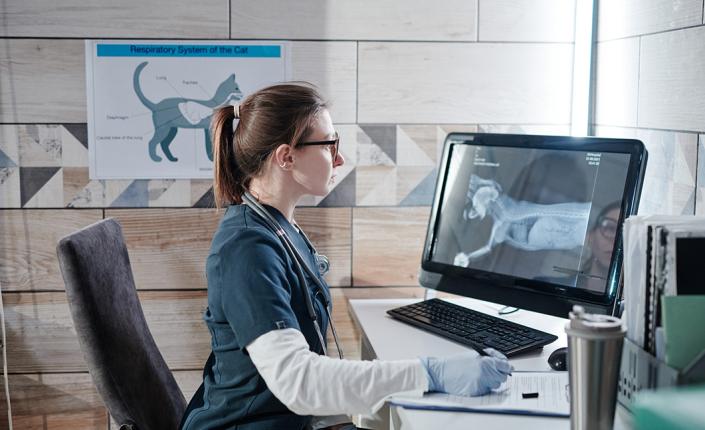How Your Veterinarian is Embracing Artificial Intelligence Today

Have you ever wondered about what kinds of technologies are at work behind the scenes in your veterinarian’s office? From the receptionist’s desk to the laboratory, innovation is making a difference in the healthcare your beloved pets receive. In the rapidly evolving landscape of veterinary medicine, Artificial Intelligence (AI) is not just a distant vision of the future but a tangible reality reshaping how veterinarians diagnose, treat, and care for animal patients. From interpreting radiographs to analyzing bloodwork and beyond, AI is empowering veterinarians with unprecedented insights and capabilities, revolutionizing the way we safeguard the health and well-being of our furry companions. Let’s examine the transformative role of AI in veterinary medicine, exploring how these innovative technologies are being harnessed by your veterinarian today to provide the best possible care for your beloved pets.
Scheduling Care
AI-driven appointment scheduling and management systems use algorithms that book appointments based on case urgency, clinic availability, and pet owner preferences. These systems help to optimize clinic efficiency, and streamline communication and administrative tasks, so that doctors can be available to offer the right amount of time to the pets that need it most. AI tools aim to minimize the amount of time pet parents spend in waiting rooms, and reduce the number of double-booked or unfilled appointment slots.
Identifying Trends in Bloodwork
There’s a reason your veterinarian wants to collect blood samples from your pet. The concentration of cells and biochemical factors in your pets’ blood can give your veterinarian important information about organ performance, hormonal health, infectious or inflammatory processes, and immune function. Even if your pet isn’t showing outward signs of illness, blood tests can often detect problems before they become obvious. Machine Learning tools such as one developed at UC Davis School of Veterinary Medicine, help veterinarians compare historical trends in routine bloodwork to identify hard-to-diagnoses illnesses, like Addison’s disease. Other AI tools have been used to alert veterinarians to conditions like kidney dysfunction, diabetes, and anemia.
Interpreting Radiographs
Confidently identifying subtle abnormalities on x-rays takes thousands of hours of training and experience. Veterinary radiology specialists can be difficult and costly to access. Fortunately, your family veterinarian now has access to technological tools like SignalPET that can help diagnose everything from tumors to arthritis to gastrointestinal obstructions. This automated process ensures that barely perceptible changes in x-rays don’t go unnoticed. It brings advanced radiographic interpretation to the neighbourhood veterinary hospital, and improves the speed and accuracy of the diagnostic process.
Through the Microscope
Reviewing microscopic slides of blood, feces, and tissue samples can be a labour-intensive and inexact process. While veterinarians can diagnose some microscopic conditions in the hospital, many samples need to be sent out for specialist to review. New AI tools like Imagyst allow veterinarians to quickly locate and identify abnormal cells on microscopic slides. This helps them to zero in on diagnoses from intestinal parasites, to skin infections, to cancer, in a short period of time. AI tools enhance the amount of information that your vet can get to you, without necessarily waiting for shipping, sample processing, or a laboratory consultation.
Other Uses of AI in Veterinary Medicine
If you’ve ever used a Fitbit, or an Apple Watch, you’ll know how much information these little trackers can give you about your sleep and activity levels. They even track vital parameters like heart rate, oxygenation, and temperature. Wearable monitors can also be used for pets, to monitor the same vital parameters, but also to give vets and pet owners information about less tangible health elements like comfort level, itch, and recovery from illness.
On a regional and global level, predictive analytics tools are tracking information and observations reported by thousands of veterinarians and their supporting laboratories. These tools can help us to recognize trends and track epidemiological patterns, so that we can forecast and manage disease outbreaks that threaten the health of our pets, our families, our food supply chains, and vital environmental systems.
Looking to the Future
As the power of AI continues to develop, its integration into veterinary medicine is poised to revolutionize animal healthcare. The current applications of AI in interpreting radiographs, analyzing bloodwork, and reviewing cytology samples represent just the tip of the iceberg. Looking ahead, the future of veterinary medicine holds exciting possibilities, with AI-driven technologies likely to play an increasingly central role.
Drawing inspiration from advancements in human medicine, we can imagine the emergence virtual tools that assist in diagnosing ailments, selecting treatments, and even performing physical procedures with unparalleled precision. Moreover, personalized medicine tailored to the unique genetic makeup of individual animals could become a reality, thanks to AI-driven genomic analysis.
However, as with any technological advancement, ethical considerations and regulatory frameworks must accompany the widespread adoption of AI in veterinary medicine. Ensuring data privacy, maintaining transparency in algorithmic decision-making, and safeguarding against biases and errors are key to realizing the full potential of AI in animal healthcare while upholding standards of integrity and compassion.
The journey towards harnessing the full potential of AI in veterinary medicine is just beginning. By embracing innovation, collaboration, and responsible stewardship, veterinarians and technologists can pave the way for a future where every animal receives the best possible care, empowered by the transformative capabilities of artificial intelligence.
Appropriately, this post was generated using the assistance of AI.